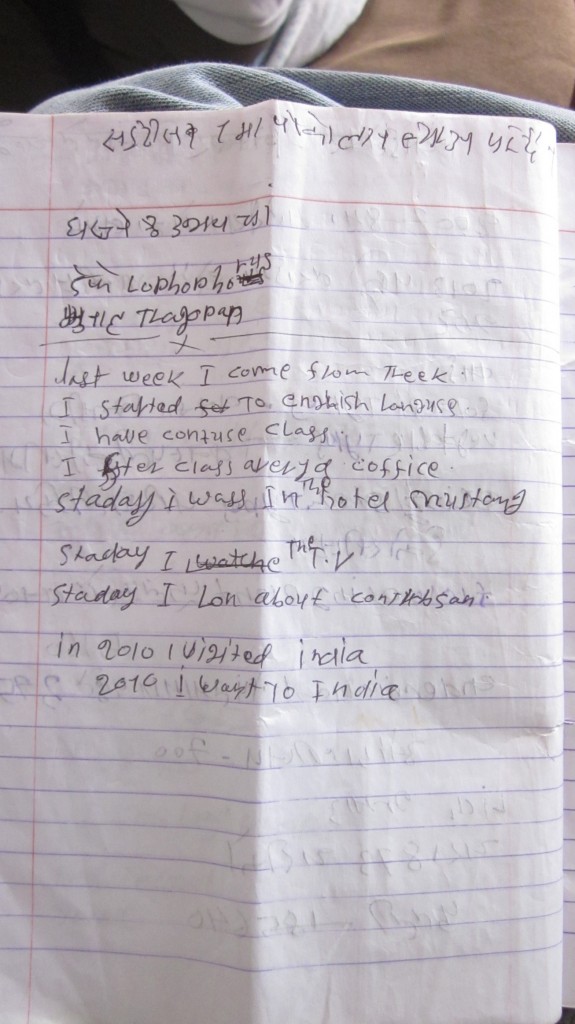
It is often assumed that a target language can be best taught in the target language. This assumption basically developed from the Direct Method, which emphasized that translation and use of the learners’ language is detrimental to the learning of the target language. This ideology influenced the succeeding methodologies in the field of English language teaching and teaching of other second languages. In the audio-lingual method also, teaching and use of the learners’ first language was considered a detrimental factor in the success of language learning. This ideology and practice is best suited in contexts where learners are almost fully competent in the target language. However, this case is very rare because if the learners are already competent in the target language, why should they bother to sit in the second language classroom? Learning in the second language, for example in English, may provide more exposure to the learners since they may be able to receive more hours of English. However, lack of adequate proficiency in that language is likely to severely affect their general learning as well as their learning of content subjects such as mathematics and social studies. When the learners do not grasp what the teacher is teaching in the classroom, she does not only abstain from important information being taught, she also feels left out, excluded and discriminated. Research literature from around the world shows evidence for that.
The concern regarding the use of English as a medium of instruction has drawn a considerable attention from both teachers and policy makers in the context of Nepal. While the “English-medium” private schools have long been bragging the English-only policy and practice in their schools, teachers have always been agentive in resisting this ideology, making varied use of learner’s language. I was an English teacher in a private school in Chitwan for about five years from 1996-2001, and while teaching English, I consciously made use of Nepali in various degrees. Teaching English, only in English benefitted only those who had developed a considerable degree of proficiency in English; those with little knowledge of English suffered a lot.
Translingual pedagogy: some cases
The concern regarding the benefits and drawbacks of English-only policy is not a Nepal-specific issue. In order to address the complexities of bilingual and multilingual schools and societies, researchers and teachers have recently shown an increased interest in using a translingual pedagogy. Translingual pedagogy or translingualism largely refers to a conscious and dynamic use of two or more languages in a language classroom. In such contexts, the teacher is competent in using both languages. Professor Ofelia Garcia is well known for elaborating this concept in bilingual classrooms in the US. In a thought-provoking post that she wrote a while ago for Choutari, she mentions:
Translanguaging in education can be defined as a process by which students and teachers engage in complex discursive practices that include ALL the language practices of students in order to develop new language practices and sustain old ones, communicate and appropriate knowledge, and give voice to new sociopolitical realities by interrogating linguistic inequality (Garcia, 2013, https://neltachoutari.wordpress.com/2013/07/01/translanguaging-to-teach-english-in-nepal/).
Two other researchers, Adrian Blackledge and Angela Creese, from the UK have also shown compelling evidence of using two languages concurrently in a second language classroom. They write:
We also find examples of the need for both languages, for the drawing across languages, for the additional value and resource that bilingualism brings to identity performance, lesson accomplishment, and participant confidence (Creese and Blackledge, 2010: 112).
Such evidences suggest that learners benefit largely by being taught in two languages.
Translingual practices in an ESP classroom
I have long been interested in the use of English in non-formal and informal educational contexts in Nepal. One of my previous studies investigated how learners of English in Nepal navigate information technologies such as Facebook in order to enact and practice their bilingual identities. Recently, I have been researching on the teaching, learning and use of English and other foreign languages in Nepal’s tourism industry. As a case in point, Travellers’ World (pseudonym) in Thamel, Kathmandu, offers English courses for porters and trekking guides two times a year – in monsoon and in winter- each lasting for about a month. I was in the monsoon class for a month in 2013, observing the class, taking notes, recording classroom interactions and interviewing the teachers and the students. As a noticeable finding relevant to the present essay, I here provide two examples which at times show contradictory practices.
Point 1: Travellers’ World has a policy to hire “native” English speaking volunteer tourists who tend to be from English speaking countries such as Australia, the UK and the US. I was in a class taught by a volunteer teacher from the UK. She hardly spoke any Nepali. The students, as you might guess, had only basic language and literacy schools, and their English competence was notably poor. Here, I reproduce my observation notes and a piece of classroom dialogue below.
The teacher was teaching how to write a CV. She first briefly explained what CV is and what it is used for. She wrote Curriculum Vitae on the board and asked the students if they knew it before. A few nodded. One student mentioned that CV means bio-data. The teacher acknowledged the student’s response and distributed a one-page handout that contained a template for writing a CV. She then divided the class into three groups. The students seemed confused, looking at each other and at the teacher, speaking unclearly in Nepali. The following interaction occurred meantime:
T: What are you writing in your CV? (addressing to one a student)
S: (pause) I am writing…
T: Okay. You need to write your education background.
S: (pause)
T: You can write about a famous person. Write about a famous person’s CV.
S: Okay.
T: Oh yeah. Write Barack Obama’s CV for the presidential post? For example you are Barack Obama and you want to apply for the post of President. How do you like the idea?
S: Good good. (laughs)
(pause for a while)
T: What about you (to another student). (pause) Do you like sports?
S: Oh, I write David Beckham. I like football.
Most of the students did not have their education beyond the School Leaving Certificate (SLC, equivalent to Grade 10). Some of them were school dropouts, who did not continue their formal education after grade 5. At first, writing a CV that asked for their university education obviously created a problem for them. Rather than helping students to prepare a CV that included their own information, the teacher assigned a more daunting task of writing the American President’s CV. Another student perhaps thought only the famous people in the world have their CVs and he proposed writing a famous British soccer player’s CV. CV for them meant biography. The students encountered more problems later when they had to write their previous work experience for the posts they were supposed to be applying for. Second, because the students could not grasp the teacher’s English, they could hardly make sense of what she was saying. Since the teacher did not speak any Nepali, there was no way that the students ask her to translate words or explain the meaning of the English words in the language they could understand. Even if she explained them the meaning, it was in English, which often lead the students to more challenging cognitive tasks. Often, students would look at each other talking with their eyes or gestures. Their silent talks were in Nepali, and they apparently were looking for meanings and definitions in Nepali. Those who were sitting by me would ask me ‘Nepalima ke bhnacha, sir?’ (What do you say in Nepali, sir?). I would happily volunteer to help them out by telling them in their language. At the same time, however, I feared that teacher would not like my intervention since I was permitted only to “observe” her class, not to make any interventions. Had the teacher known some level of Nepali, the students would have benefitted significantly. My point of giving the example above is that both the students and the teacher should be able to understand each other and the task being implemented in the classroom. There were problems with English-only instruction: students were lost and often solicited my responses.
Point 2: Students’ practices were reasonably translingual. Their conversations among themselves were in Nepali. They tried to speak to the teacher in English, but at times would insert Nepali words (which, as you know, did not make sense to the teacher). Their class notes reflected their translingual competence. Given below is an example of class notes by one of the students named Chhatra.

Chhatra’s note was produced during a group work. The students were asked to report their activities in the past simple tense. Chhatra took notes using the past tense before he reported his activities to his group members and to the teacher. His notes show the characteristics of what they recognize as broken English. Chhatra told me that his writing represents English words as he hears them. First few lines are in Nepali with occasional translation into English and vice versa. His literacy skill in Nepali also shows characteristics that do not conform to the standard Nepali writing. For example, the word उभएचा (ubhaecha) in the second line should be उभएचर (ubhaechar) in standard Nepali, and the word डेफे (defe) in the third line should be डाँफे (danphe) if we follow the standard writing system in Nepali. Similarly, Chattra’s English writing shows orthographic peculiarities in its use: he uses ‘treek’ for ‘trek’, ‘languse’ for ‘language’, ‘contuse’ for ‘continuous’, ‘averyd’ for ‘everyday’, ‘staday’ for ‘Saturday’ and ‘vigited’ for ‘visited’.
To take the point further, Chhatra shows his complex translingual skills. Although the language of instruction of his class is English-only, he appropriates that with his “non-standard” English skills, combined with various degrees of proficiency in Nepali. This shows that students look for and benefit from combining varied linguistic and literacy resources at their disposal.
Final words
Societies are being more multilingual today. Students come from diverse linguistic and cultural backgrounds. If teachers can wisely use bilingual resources, students will benefit more. Teachers in Nepal have been doing this although schools may have various policies regarding the use of English in classrooms. To conclude, while it at first seems that students get more exposure of learning if they get more hours of English talk in their class (in ideal cases where all students equally understand English and the concepts being taught in that language), systematic and dynamic use of English and Nepali (or another local language) will have more positive learning experiences and outcomes.
Works Cited
Creese, A. and Blackledge, A. 2010. Translanguaging in the Bilingual Classroom: A Pedagogy for Learning and Teaching? The Modern Language Journal, 94, 102-115.
Garcia, O. 2013. Translanguaging to teach English in Nepal. Retrieved on July 23, 2015 from https://neltachoutari.wordpress.com/2013/07/01/translanguaging-to-teach-english-in-nepal/
—
The author, a founder of ELT Choutari, is a Ph. D. scholar at the University of Hawaii at Manoa, USA.